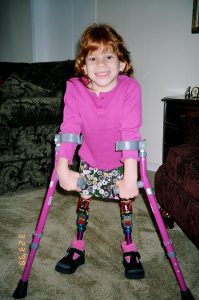
The question of whether a child, or an adult, with SA/CRS can walk or not comes up often. It’s probably one of the first questions people ask. Walking is seen as an important milestone in a child’s development, one of the factors that pediatricians and parents may view an indicator that the child will be “alright”. The other alternative, using a wheelchair, seems foreign and difficult to think about. Parents have usually not had a lot of exposure to individuals who use wheelchairs. Their thoughts about wheelchairs may bring up images of nursing homes and of individuals who are dependant on others for their care. Parents may see a wheelchair as a barrier to success and independence. Society perpetuates these ideas with the use of words like “confined” to a wheelchair, or “wheelchair bound”, giving one the sense that an individual is trapped in and limited by use of a wheelchair. Therefore, parents are often highly motivated to do whatever is necessary to ensure that their child will walk. They hope their child will never “have to” use a wheelchair.
Varying perspectives
It may be surprising, therefore, to learn that there are actually many individuals who use wheelchairs and much prefer them over walking. For some insight into this perspective, read “Is Walking Overrated?“ Wheelchair users may find that the wheelchair provides them with more independence and is more functional for daily life, than walking. They don’t find wheelchairs “confining”, but are freed (rather than “bound”) by the increased ease of mobility that the wheelchair provides. The cumbersome, heavy wheelchairs of the past have given way to modern, lightweight models that move faster, turn on a dime, bounce over curbs, and pop easily into the back of a car. Click here to check out wheelchair options. Sports wheelchairs have been designed specifically for playing basketball, rugby, racing, and tennis. For a list of wheelchair skills and the approximate ages when they might be developed click here. Wheelchair users find some advantages to using wheelchairs that are largely unknown to and overlooked by most of society. They find it is not so important how you get from one place to another, but what you can accomplish when you get where you are going that makes for life success and independence.
Choices and options, costs and benefits:
There is no controversy over the fact that walking also has some benefits. It is without a doubt how most people in society gets from one place to another, even if they look for a place to sit down once they get where they are going. It’s sometimes hard for people to understand that a wheelchair is just another means of getting from one place to another. Walking and use of a wheelchair are just different options. A choice does not need to be made for one or the other. Often those with SA/CRS benefit from having both options and from having the freedom to choose which will be the most efficient and functional choice for a specific activity. Having a wheelchair first does not mean that the child will be less motivated to try walking. Walking first does not mean that the child will never benefit from a wheelchair.
Knowing that the wheelchair is not a limiting barrier to independence is an important part of the process in making decisions about the goal of walking. Parents with children who have SA/CRS often have very tough decisions to make. SA/CRS often impacts the formation and function of a child’s toes, feet, ankles, knees, and hips as well as the stability of the hips and torso. The goal of walking requires that any of these orthopedic issues be addressed by surgery and casting. These issues are lifelong issues, as joint contractions are prone to re-occur and new orthopedic issues can arise as the body grows, requiring repeated surgical procedures. Braces are outgrown and wear out, equipment needs replacing, and all of these processes involve time and expense.
While some individuals with SA/CRS have very minor or no orthopedic issues at all, and walk as well as those without this condition, for others with SA/CRS there is a “cost” to walking. For some, the “cost” may be as simple as some corrective shoes or casts worn as an infant to correct the position of the feet. For others, the “cost” may be a lifetime of repeated, painful and invasive surgeries, ongoing physical therapy, continuous adjustments and replacement of equipment and bracing. With these surgeries come risks, and with multiple appointments come missed time from school for the child and from work for the parent. In each case, the “cost” must be weighed against the benefit, both short term and long term, for the child and the family. For video examples of children with SA/CRS who are walking, click here. When the outcome is independent walking, or walking with lower leg braces and forearm crutches, that cost may be worthwhile because it is usually quite efficient and functional. For others, the end result is a very limited ability to walk in very limited settings, with substantial bracing and support, and significant expenditure of energy. That cost may not be worthwhile. The large cost far outweighs the minimal benefit. For a research article that examined the amount of energy used by children with spina bifida for walking as compared to using a wheelchair, see this link. (Orthopedic issues of children with spina bifida may be similar to those of sacral agenesis.)
No two alike
Remember that SA/CRS affects people differently. There are various forms of the condition and no two people are exactly alike. Many individuals with SA/CRS will and can walk, but the type of walking, the ease of walking, the distance the can walk, the surfaces they can walk on, and the amount of support from braces and/or crutches varies for each individual. The amount of surgery and training to achieve functional walking also varies a great deal. Physically, it usually takes a good bit of torso and hip control to walk with any good control and for any good distance. Even if the knees don’t work, but can be positioned for support under the body, it’s still possible to walk pretty well for shorter distances, but hip and trunk control are essential for functional walking. Without hip and trunk control, a child can still “walk” but the distance is limited. The child may be braced up to the chest and use a walker just to be able to move forward a short distance on a flat surface. When talking about walking, it’s important to understand that functional walking needs to be efficient rather than restrictive in order to be a reasonable option.
Changes over time
It is important to see both wheelchairs and walking as options when making choices about surgeries, and also it is important to consider long term results because the amount of weight that small legs must carry and that arms must lift changes over time. The same child who walked as a 4 year old may be a wheelchair user as an adult. This transition may happen rather quickly, at a growth spurt-and suddenly the child is much more tired, has much more difficulty getting from one place to another, and/or is falling often. It may happen slowly, over time, in late teen years to adulthood or later in life. If a child has grown up thinking that these choices cause disappoint for parents, that becomes an emotional burden in the decision making process. This decision is just a natural progression. It’s not laziness or “unfortunate”. It’s not a decline or set back. What is “best” is what works. Raising a child with the perspective that a wheelchair is a valid option allows for this choice to be made effectively.
The answer
So, the answer to whether your child will walk or not is: maybe. The question can almost never be answered by a simple yes or no. One factor in answering the question is the amount of function your child has in trunk, hips, knees and feet. Another factor is how frequent and how extensive any surgeries will need to be to achieve and maintain walking. Another consideration is whether walking, once achieved, will continue only a short time or throughout life. Finally, it’s important to consider whether or not the walking ability will be functional for a variety of activities or limited and restricted to specific surfaces and distances.
Whether your child walks, or not, it is important to recognize that one kind of mobility is not an automatic success and the other a failure. For your child, the option that provides the most efficient and functional mobility is the successful option, and for many that choice may be different depending on the location and type of activity.
Determining the cost and benefit in the pursuit of walking for your child is an individual family decision and it requires consideration of the report from an orthopedist and also it requires exploring the perspectives of adults who have experienced a range of mobility choices, both those who have undergone surgeries to allow for walking and those who use wheelchairs as a preference. To support your exploration of this topic, this site has collected information about surgical procedures typically seen for children with SA/CRS and stories from teens and adults about their mobility choices.
